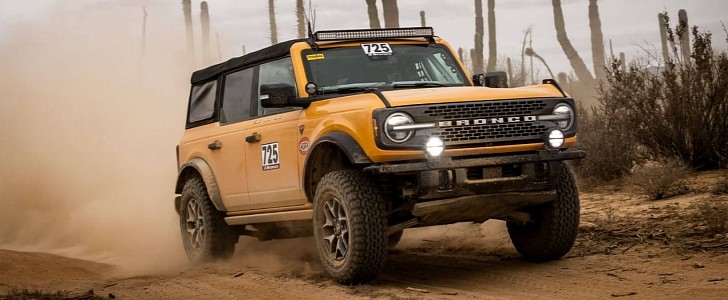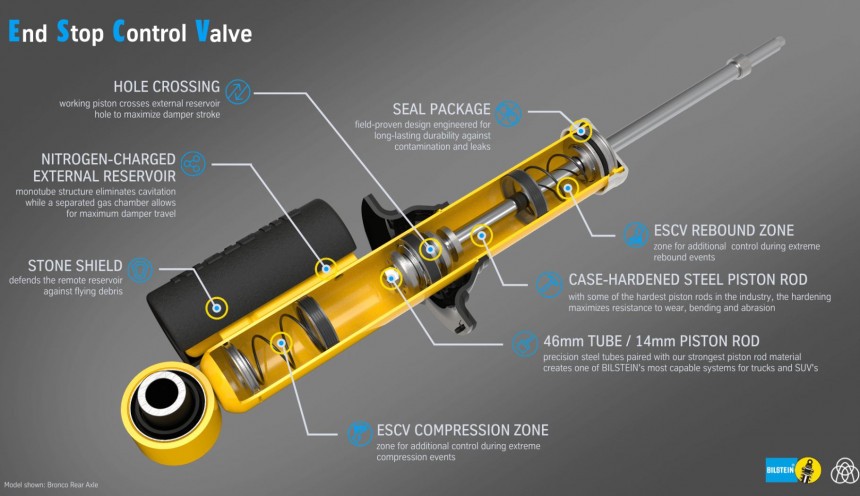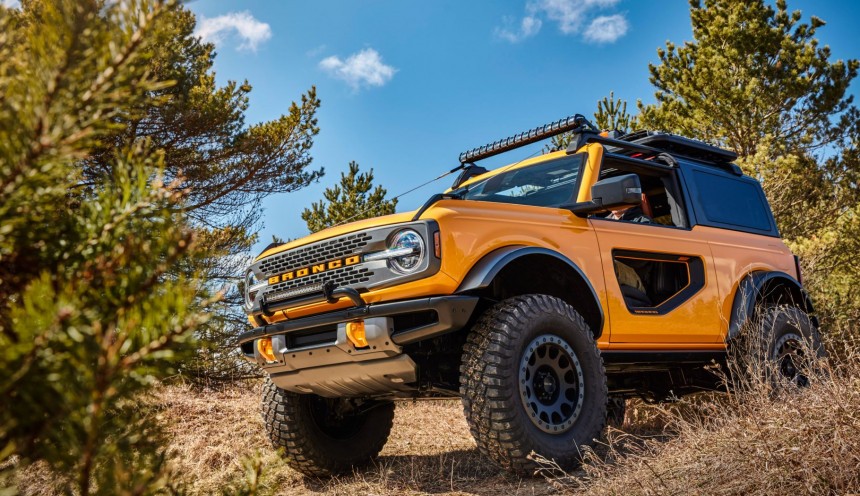One of the most anticipated SUVs in recent years, the all-new Ford Bronco was designed to dominate rough trails, dunes, or any harsh terrain it encounters. To do so effortlessly, its suspension system was extensively developed, with the Blue Oval turning to Bilstein for the bespoke design of its shock absorbers.
The legendary German company has been a leading innovator of suspension systems for decades, providing original equipment shocks for many of the industry’s biggest names and a comprehensive list of aftermarket solutions.
In the realm of factory-built off-roaders, the Ram 1500 TRX also benefitted from adaptive Bilstein shocks that proved they could take hard punishment.
Returning to the Bronco, its shocks are equipped with position-sensitive end stop control valves (ESCV) on both compression and rebound, a technology Bilstein states is unique, so let’s explore why.
First of all, we can notice an added reservoir on both the front and rear shocks. It’s filled with nitrogen that pressurizes the system to eliminate cavitation and foaming during excessive use. In conventional monotube shock absorbers, the internal gas zone is connected to the bottom compression chamber. With ESCV, the external reservoir isolates this zone, allowing for significantly higher damping forces that would otherwise cause premature wear.
Moving the gas charge in a separate reservoir also provides more room for piston rod travel, which in turn maximizes suspension articulation. To protect it from sand, gravel, or corrosion, it features a thick, heavy-duty shield.
The ESCV technology includes a compression zone found at the bottom of each absorber which offers additional bottom-out control in extreme cases such as a short flight over a dune or a small hill. It consists of a secondary compression valve piston that engages a telescoping, compression stop catch piston. That eliminates a harsh impact when suspension travel has been consumed and provides extra hydraulic cushion for the Bronco.
On the other end, Bilstein engineered a rebound zone for increased topping-out control. It also incorporates a secondary valve piston and a telescoping catch piston that work similarly to those found at the bottom end. That reduces the bounce created by the springs and other suspension components.
These shocks use 14 mm-thick (0.55-inch) case-hardened steel piston rods paired to 46-mm (1.8-inch) precision steel tubes which the manufacturer says are some of the most durable internals in the industry.
Engineers have also created a hole crossing to deliver optimum performance when the main piston slides across the external reservoir’s hole. To maximize damper stroke, the rear shocks also include a Teflon-coated metal piston band.
The whole assembly is covered by a patented seal package that contains several layers of protection. A Teflon scraper helps clear debris clung to the piston rods, while a pressure-activated triple seal uses the changing pressures inside the absorbers to automatically tighten against the rods and protect against leaks during aggressive off-roading.
Engineered and manufactured in the U.S., these innovative shocks are available as standard on the Badlands and Wildtrak models. They can also be equipped on other Broncos with the addition of the optional Sasquatch off-road package.
In the realm of factory-built off-roaders, the Ram 1500 TRX also benefitted from adaptive Bilstein shocks that proved they could take hard punishment.
Returning to the Bronco, its shocks are equipped with position-sensitive end stop control valves (ESCV) on both compression and rebound, a technology Bilstein states is unique, so let’s explore why.
First of all, we can notice an added reservoir on both the front and rear shocks. It’s filled with nitrogen that pressurizes the system to eliminate cavitation and foaming during excessive use. In conventional monotube shock absorbers, the internal gas zone is connected to the bottom compression chamber. With ESCV, the external reservoir isolates this zone, allowing for significantly higher damping forces that would otherwise cause premature wear.
The ESCV technology includes a compression zone found at the bottom of each absorber which offers additional bottom-out control in extreme cases such as a short flight over a dune or a small hill. It consists of a secondary compression valve piston that engages a telescoping, compression stop catch piston. That eliminates a harsh impact when suspension travel has been consumed and provides extra hydraulic cushion for the Bronco.
On the other end, Bilstein engineered a rebound zone for increased topping-out control. It also incorporates a secondary valve piston and a telescoping catch piston that work similarly to those found at the bottom end. That reduces the bounce created by the springs and other suspension components.
These shocks use 14 mm-thick (0.55-inch) case-hardened steel piston rods paired to 46-mm (1.8-inch) precision steel tubes which the manufacturer says are some of the most durable internals in the industry.
The whole assembly is covered by a patented seal package that contains several layers of protection. A Teflon scraper helps clear debris clung to the piston rods, while a pressure-activated triple seal uses the changing pressures inside the absorbers to automatically tighten against the rods and protect against leaks during aggressive off-roading.
Engineered and manufactured in the U.S., these innovative shocks are available as standard on the Badlands and Wildtrak models. They can also be equipped on other Broncos with the addition of the optional Sasquatch off-road package.













